Of all the truly breathtaking beauty of Hawaii, nothing quite compares to the natural beauty and stark landscapes of Hawaii Volcanoes National Park (HVNP). Our family of 5 moved HVNP to the top of our Hawaii must-do list for families.
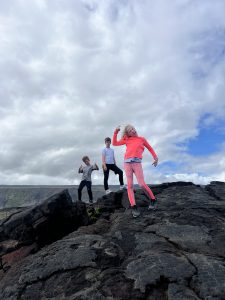
What is Hawaii Volcanoes National Park?
Hawaii is home to 7 National Parks, and it’s most visited park isn’t Pearl Harbor but Hawaii Volcanoes National Park.
Established in 1916, Hawaiʻi Volcanoes National Park is a UNESCO World Heritage site. It plays a vital role in preserving Hawaii’s natural and cultural heritage. The park is a major attraction, drawing scientists, tourists, and nature lovers from around the world.
The vast park spans over 330,000 acres and showcases diverse and unique ecosystems. One moment you are walking through a tropical rainforest, but the next, you find yourself in a barren lava field.
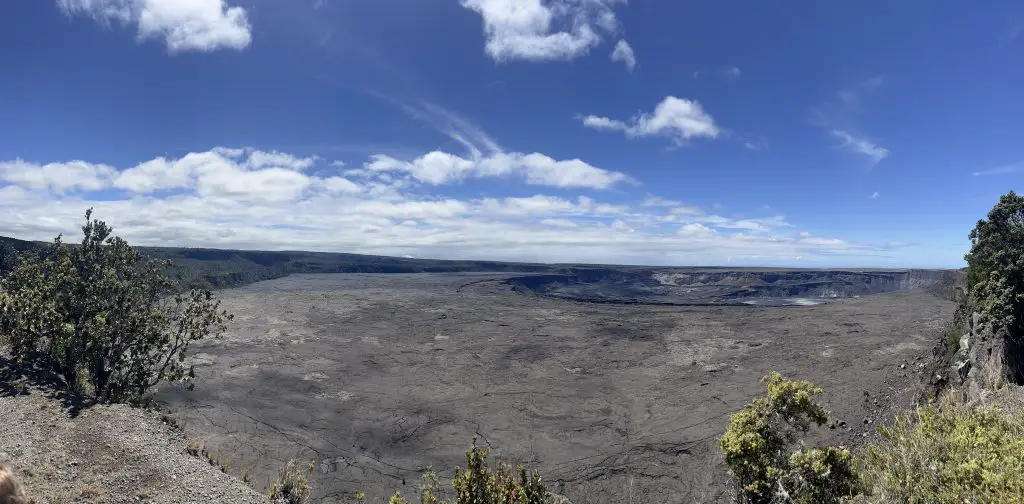
The Volcanoes of HVNP
Hawaii Volcanoes National Park (HVNP) is located on the Big Island of Hawaii and is famous for, among other features, its two most notable, active volcanoes, Kīlauea and Mauna Loa.
Kilauea is the most active volcano in the world while Mauna Loa is the largest active volcano in the world. This means that a visit to this park can be a matter of safety, and every family must check the park closures and safety information prior to their visit as these volcanos are still feisty.
The park and these active shield volcanoes give visitors the chance to witness volcanic activity and a front row seat to how volcanoes have shaped Hawaii. However, they also help visitors understand the importance of volcanoes, fire, and lava flows to Hawaii tradition.
Want to learn more about Hawaii and its active volcanoes with your children? Check out this 5 unit Hawaii study.
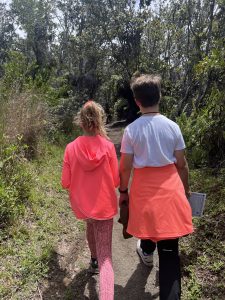
Where is Hawaii Volcanoes National Park, and How do I get there?
The Big Island of Hawaii boasts 2 international airports. The most trafficked is the modestly-sized Kona International Airport (KOA). The airport is about 3 hours from HVNP, and you can drive yourself to Volcano or take a tour bus transfer directly to the park entrance.
The second, and much smaller airport, is Hilo International Aiport (ITO), located on the East side of the island closest to HVNP. From the airport, you have only a 1 hour car ride up-up-up-up to VNP. Make sure you stop for groceries and supplies before leaving Hilo!
Our family chose to fly directly to Hilo and rent a 4-wheel drive vehicle for our adventure to, through, and from the park. We were glad to have the extra stability and power for some of those dark, slippery, and steep roads!
Although the visitor center, Kilauea caldera, and Thurston Lava Tube are within easy walking distance of the entrance, I still recommend having a vehicle to drive through the extensive grounds of the park.
Whether you choose to fly into Kona or Hilo, set your GPS on the Volcano National Park Visitor Center as your first stop. At the visitor’s center you can get an idea of what the rapidly-changing weather is at the moment, grab a map, and pick up those Junior Ranger booklets for your children to complete.
Don’t be concerned if it is raining when you arrive, the weather can change to sunny in a matter of moments. But, likewise, don’t rely on sunny, cloudless skies to remain!
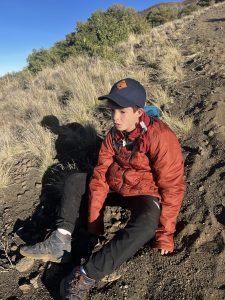
Is Mauna Kea in HVNP?
Mauna Kea, Hawaii’s highest peak, and the world’s tallest mountain when measured from base to summit is located near but not in HVNP.
Mauna Kea visitor’s center is located about a 1.5 hour drive from the entrance of HVNP. This makes Mauna Kea a great stopover between HVNP and Kona if you are driving across the island as part of your adventure.
Mauna Kea is famous for its extremely challenging, high-altitude hike and its stargazing, Many companies and universities offer opportunities to star-gaze at Mauna Kea’s peak –a great activity for even junior astronomers. However, our family was more interested in the challenge of new terrain and the sharp elevation gain.
Mauna Kea is notable for its elevation gain in a relatively short and non-technical hike. Hikers looking to summit Mauna Kea must sign in at the visitor’s center and take the steep, but well-marked route to the top.
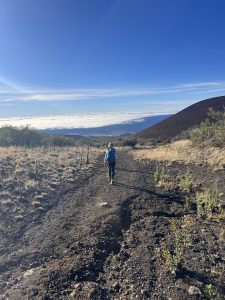
We recommend starting your hike before dawn. First, the view of the sunrise from the visitor’s center is quite a spectacle. And, second, the hike can take the larger part of the day (usually 6-10 hours), and you don’t want to be out at dark.
In our experience most of the rangers were quite friendly. However, some are unaccustomed to seeing hiking families and might just prevent you from even starting the hike with kids (cough, a story for another time). Children are unlikely to make it to the summit, but take lots of water because even a short hike will be a good altitude and acclimatization learning experience.
Even if your family doesn’t hike to the top, 4-wheel drive vehicles are permitted to drive to the summit and take in a one-in-a-million view.
What to do in HVNP with families?
Hawaiʻi Volcanoes National Park offers a variety of activities for families to enjoy. Here’s an extensive list of things families can do:
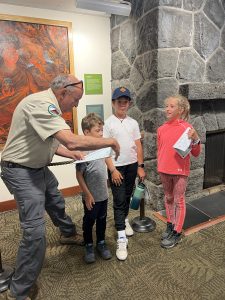
1. Visitor Centers & Educational Activities
- Kīlauea Visitor Center: Learn about the park’s geology, volcanoes, and Hawaiian culture through interactive exhibits and ranger talks. Here you can pick up a Junior Ranger Booklet for your children to complete. Don’t forget to take the completed booklet back to the visitor center to get your Junior Ranger Badge!
- Ranger-led Programs: Participate in ranger-led hikes, talks, and activities to learn about volcanic activity, wildlife, and the park’s history.
2. Volcano Viewing
- Kīlauea Caldera Viewing: Observe the massive Kīlauea caldera and Halemaʻumaʻu crater from overlooks such as the Jaggar Museum overlook (currently closed and under construction) and the Kīlauea Overlook. Our favorite spot for observing the caldera was Lava House’s large viewing foyer where you can enjoy a drink or even dinner while viewing the massive caldera.
- Lava Viewing: When conditions permit, families can witness lava flows from designated viewing areas or hikes to lava flows. Always check the park site for visible flows or eruptions.
3. Hiking & Nature Walks
- Crater Rim Trail: A family-friendly trail that offers views of steam vents, craters, and forests along the Kīlauea caldera. This is an easy family trail that leads through a myriad of landscapes while always having a view of volcanoes.
- Thurston Lava Tube (Nāhuku): Walk through a massive underground lava tube, an easy hike that’s great for all ages. This short hike takes only a matter of minutes and is easily paired with Kilauea Iki trail.
- And many others! Check out the Devastation trail or even Pu’uloa to see the ancient petroglyphs. Finally, don’t miss the short path leading to the sea arch on the coast of the expansive park.
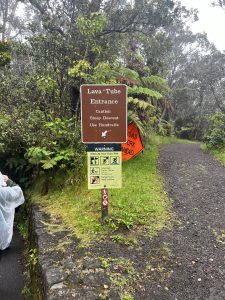
4. Scenic Drives at Hawaii Volcanoes National Park
- Chain of Craters Road: A 19-mile scenic drive that takes you through lava fields and down to the coast, with several stops for short hikes and viewpoints along the way.
- Crater Rim Drive: Offers views of steam vents, craters, and lush forests, with plenty of stops for short hikes or photo opportunities.
5. Wildlife Watching
- Birdwatching: Spot native Hawaiian birds such as the nēnē (Hawaiian goose) and honeycreepers in the park’s diverse habitats. We had no trouble spotting nene around the campsites.
- Endangered Species Viewing: Learn about and potentially see some of Hawaii’s unique and endangered species.
6. Cultural & Historical Experiences
- Hawaiian Petroglyphs at Puʻu Loa: Hike to the Puʻu Loa petroglyphs, where families can see ancient Hawaiian rock carvings.
- Cultural Demonstrations: Participate in or watch traditional Hawaiian cultural activities, such as hula performances or craft demonstrations (check the park’s schedule).
- Historic Volcano House: Visit this historic lodge for dining or to learn about its history, with a view of the Kīlauea caldera. (more on this below in “Where to Stay”)
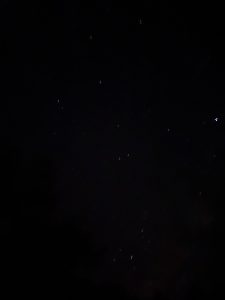
7. Stargazing
- Stargazing Programs: Enjoy the night sky in the park’s dark skies, where families can spot constellations and planets. Some nights feature ranger-led stargazing programs.
8. Photography
- Nature and Landscape Photography: Capture photos of dramatic volcanic landscapes, lava flows, steam vents, and unique flora.
- Sunset and Sunrise Viewing: Watch the sunrise or sunset over the volcanic landscape for stunning family photo opportunities.
9. Camping & Picnicking
- Picnicking: Enjoy a family picnic at designated areas, such as Kīpukapuaulu or the Kīlauea Overlook.
- Camping at Nāmakanipaio Campground: Families can camp in the park, experiencing the unique opportunity to sleep near an active volcano (reservations required).
10. Volcano Art Center
- Visit Volcano Art Center: Located a mere stones-throw from the Visitor’s Center, the Volcano Art Center is one-of-a-kind. Explore local artwork, including Hawaiian-themed sculptures, paintings, and crafts as well as historical pieces made with unique materials.
11. Biking at Hawaii Volcanoes National Park
- Bike the Chain of Craters Road: For families with older kids, cycling along the Chain of Craters Road offers an active way to explore the park’s lava fields and volcanic landscapes.
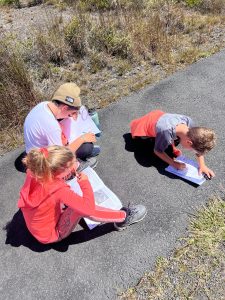
12. Golfing at Hawaii Volcanoes National Park
Hit 18 holes at HVNP’s very own golf course. For those families who can’t get enough golf or children who want a unique golfing experience, it doesn’t get much more unique than lava fields. Of course, golfing in Hawaii is known for its majestic views, but here you might also have to contend with craters and lava flows!
Hawaiʻi Volcanoes National Park offers a variety of activities that cater to families with different interests and energy levels, ensuring a fun and educational experience for all.
Where to stay in Hawaii Volcanoes National Park with kids?
Where should you stay in HVNP? I’m so glad you asked. We were so happy with our accommodations in HVNP that we can’t wait to share it with you!
In our opinion, there are 2 superior options for a stay in HVNP: 1. Volcano House or 2. Camping. In fact, I generally hate camping, but tent camping in HVNP made me reconsider my viewpoint!
VOLCANO HOUSE
If you are looking for a rich experience in a climate-controlled space with an unmatched view, then you will love Volcano House.
Located just across the parking lot from the Kiluaea Visitor Center, this quaint historical hotel has hosted any number of scientists, researchers, and world travelers.
If you walk in the hotel doors (open to the public), you are sure to miss the check-in desk because your view will be dominated by a giant caldera. The hotel sits precipitously on the edge of a cliff overlooking the giant Kilauea caldera. From the rocking chairs of the main lobby, you can study the chasm for hours and even view lava flows after dark.
The rooms are modest, comfortable, and quaint –not luxurious. In our opinion, the traditional rooms lend to the volcano safari feeling. Further, the hotel restaurant is renowned for its buffet breakfast, delicious pizzas, and dinners overlooking the caldera.
Rooms sleep 2-4 people. Therefore, they were not conducive to our family of 5. However, as guests of the campground (more below), we were able to enjoy many of the same amenities.
Namakani Paio Cabins and Campground
Located a short drive from Volcano House are Namakani Paio Cabins and Campground. This small campsite has no hookups and only allows tent camping or small caravans in addition to its small selection of rustic cabins.
However, don’t let the rustic description fool you. Despite its simplicity, the campsites are nestled in a fragrant eucalyptus forest where the night stars might be the brightest you have ever seen, and your co-campers might become fast friends.
The entire campsite is quite small which cuts down on noise and traffic. But, the campsites are sufficient for a comfortable camping experience. Each site has a picnic table, a fire pit, and a grill.
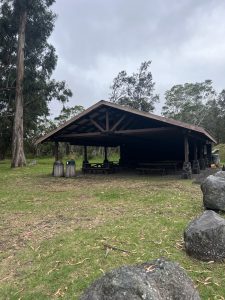
What is included with your campsite through Volcano House?
However, the best part for this tired mom of three, was that Volcano House and the camp staff do the hard work for me.
If you book your campsite through Volcano House, they do the packing, set up, cleanup, and dismantling for you. We booked our campsite through Volcano House, and for only about $50.00 per site/tent, the staff set up our site for us.
Booking a campsite through Volcano House included:
- Tent (already setup and staked)
- Floor mat
- Air mattress (inflated and made with sheets and blankets)
- Warm, fluffy duvets (my favorite part!)
- Cooler
- Towels (for each person in the tent)
- Camp lantern
- Pillows
- Pillow cases
- Trash can
- Folding camp chairs for each person on the reservation
- Access to the camp pavilion and facilities
Campsites did not include: kettle, stove access, microwave access, or changing/shower rooms
Other Benefits of Staying with Volcano House and Campground
Plus, as guests of Volcano House, we were greeted with a mimosa reception, discounted meals in the main dining room, and complimentary coffee and hot chocolate in the morning.
I am an avid non-camper, but this experience –though sleeping in tents outside –made camping appealing to me.
Yes, the nights in HVNP can be quite chilly, and you should pack accordingly. But, snuggled around the fires under the brightest stars I had ever seen and nestled beneath big fluffy duvet covers, I had some of the best sleep of my life!
This is not an experience that I will soon forget even if it was camping!
2-day Hawaii Volcanoes National Park Recommended Itinerary
HVNP has so much to do that you couldn’t run out of activities in an entire week. However, most people budget only a quick trip to the park. Therefore, if you only have 2 days to experience the best of the park, here are our recommendations:
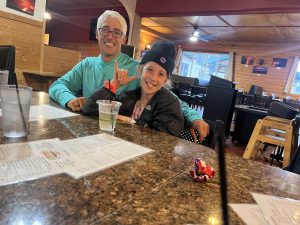
Day 1 HVNP
Day 1: Pickup groceries and necessities prior to arriving in HVNP. Arrive and check in to Volcano House or campground.
- Stop in the Visitor’s Center for safety information, a bit of shopping, maps, and current park recommendations based on volcano activity and weather.
- Walk from the Visitor’s Center to the Volcano House to view the Kilauea caldera and enjoy a snack or drink after your long travel day.
- Take a short drive to Thurston Lava Tube and Kileuea Iki for 2 short hikes.
- Enjoy dinner at Kileauea Lodge or Volcano’s Lava Rock Café.
- If you are looking for pizza, order early at Uncle George’s.
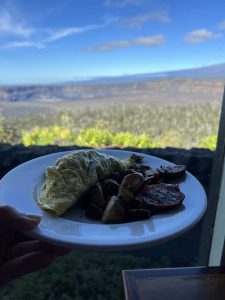
Day 2 at HVNP
Day 2: Wake early for sunrise. Then proceed directly to Volcano House for their delicious buffet and breathtakingly beautiful morning view.
- Spend the rest of the morning walking the Kilauea Crater Rim trail. Walk to the right of Volcano House to maintain a birds-eye view of the caldera. Walk to the left of Volcano House to work your way down into the crater. Or, spend the entire day to make an entire loop around the crater.
- If you have time, take a drive all the way through the park and stop at the petroglyphs and sea arch. You will have gone from high above sea level and lush green forest to vast expanses of volcanic devastation in a mere matter of minutes.
The landscape is beautiful and terrifying all at once!
Don’t forget to snag your favorite HVNP gear at Volcano House or the Visitor’s Center before you head leave. This is a place you won’t soon want to forget!
Don’t Skip Hawaii Volcanoes National Park with Your Family
HVNP shocked us by vaulting straight to the top of our Hawaii must-do list. The park was fun, interactive, well-marked, and incredibly interesting for our entire family.
A camping stay only enhanced the experience, and I highly recommend all of the hikes, activities, and special experiences for young children as well as adults.
Don’t skip this unique park for your family trip to the Big Island.